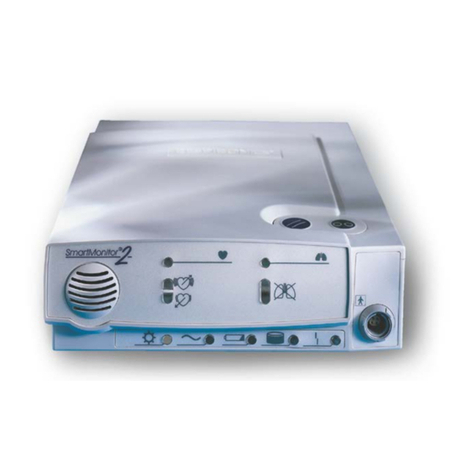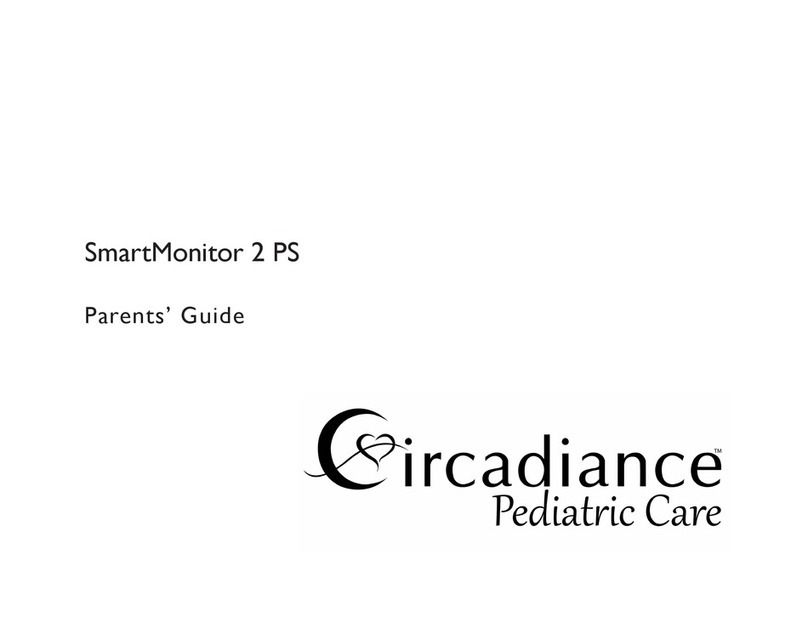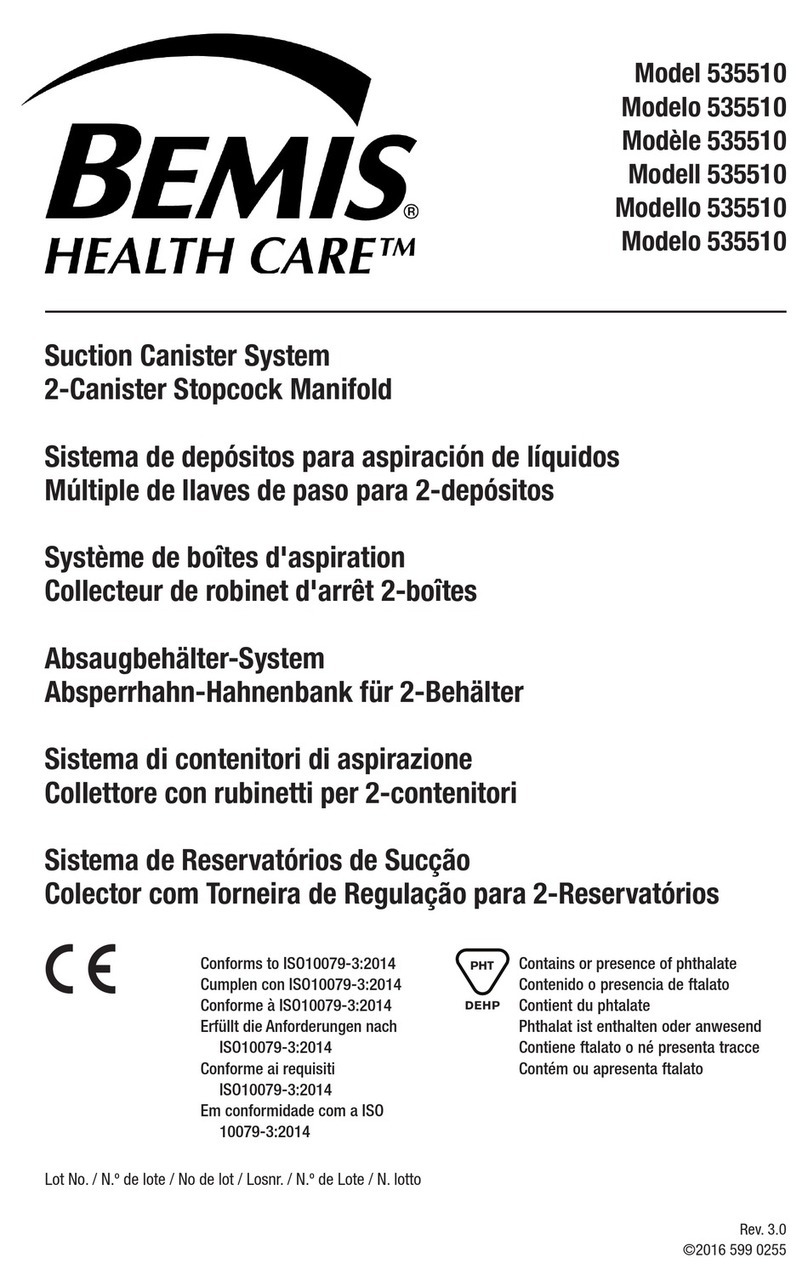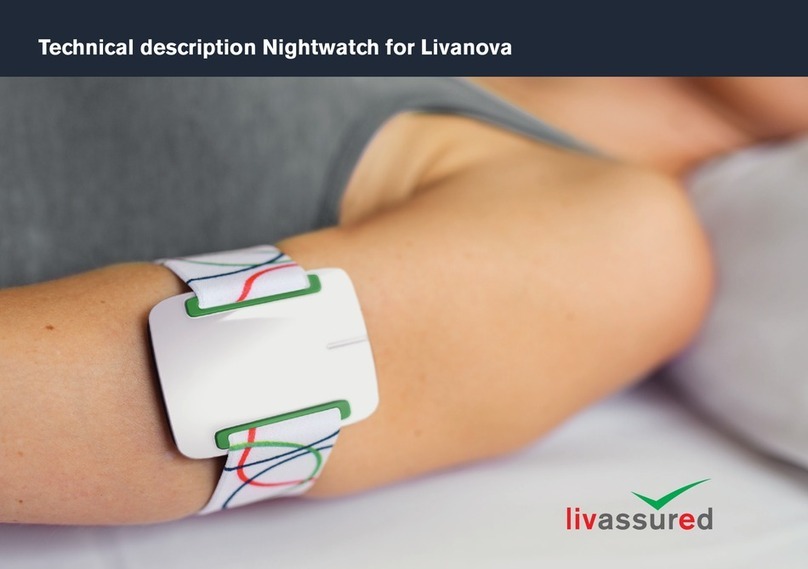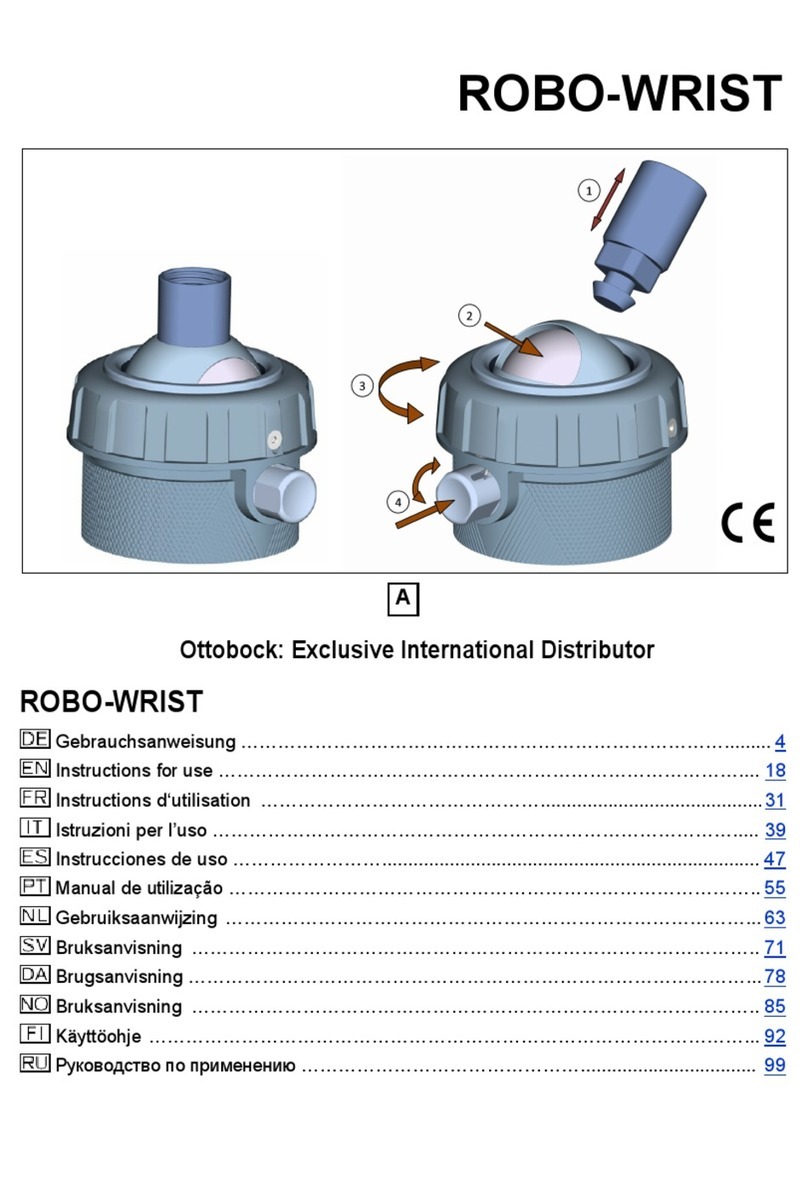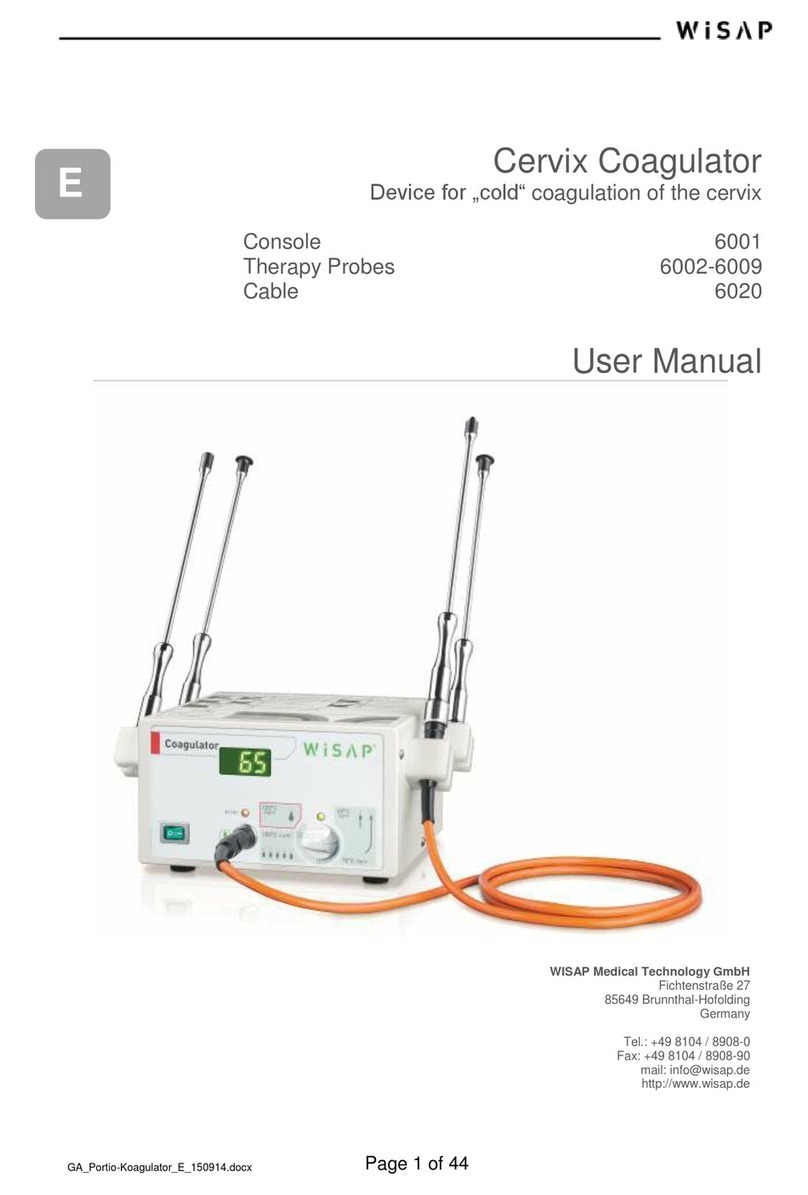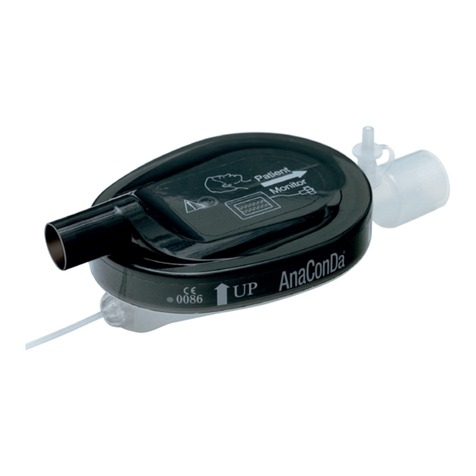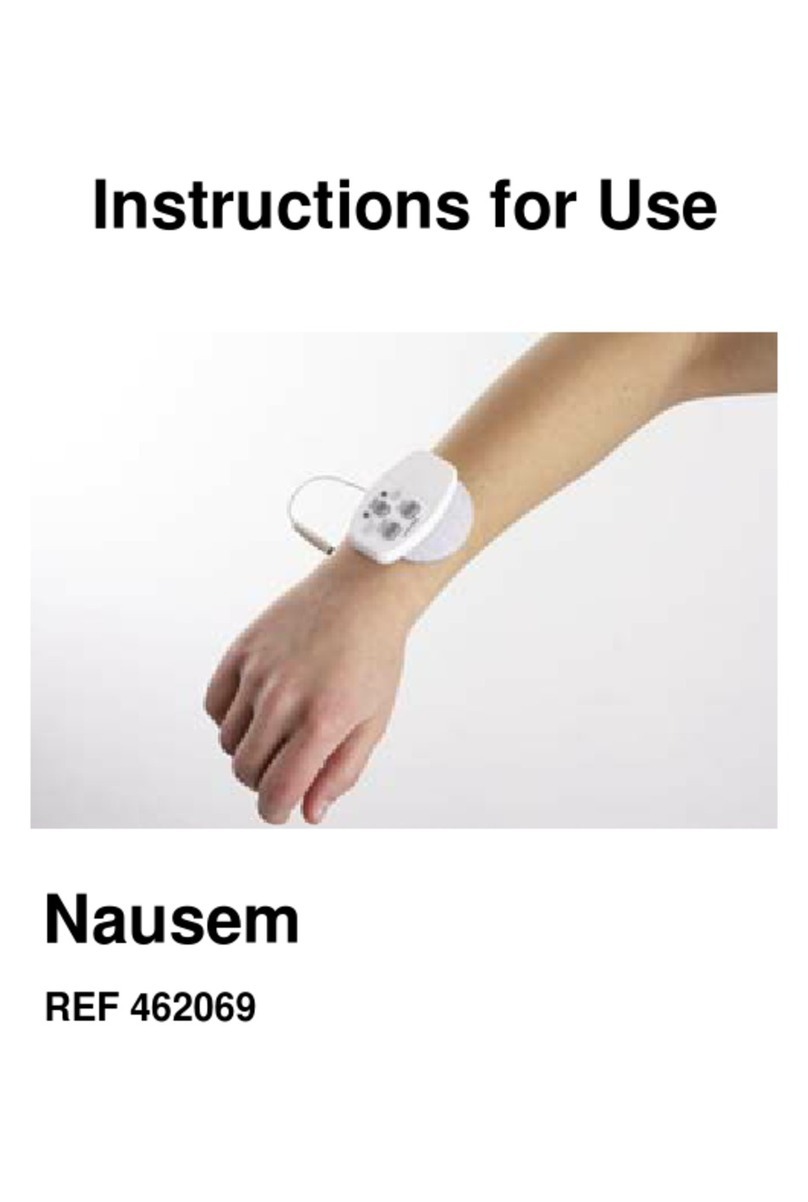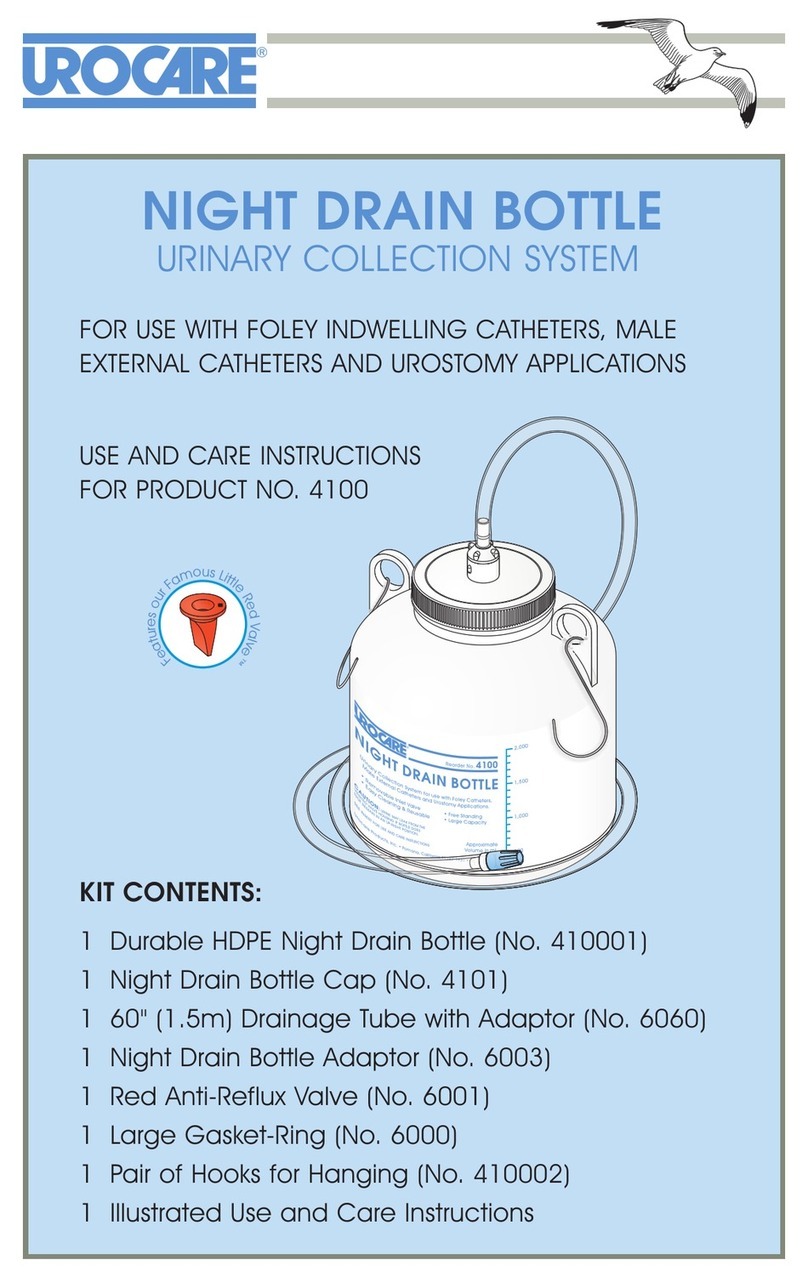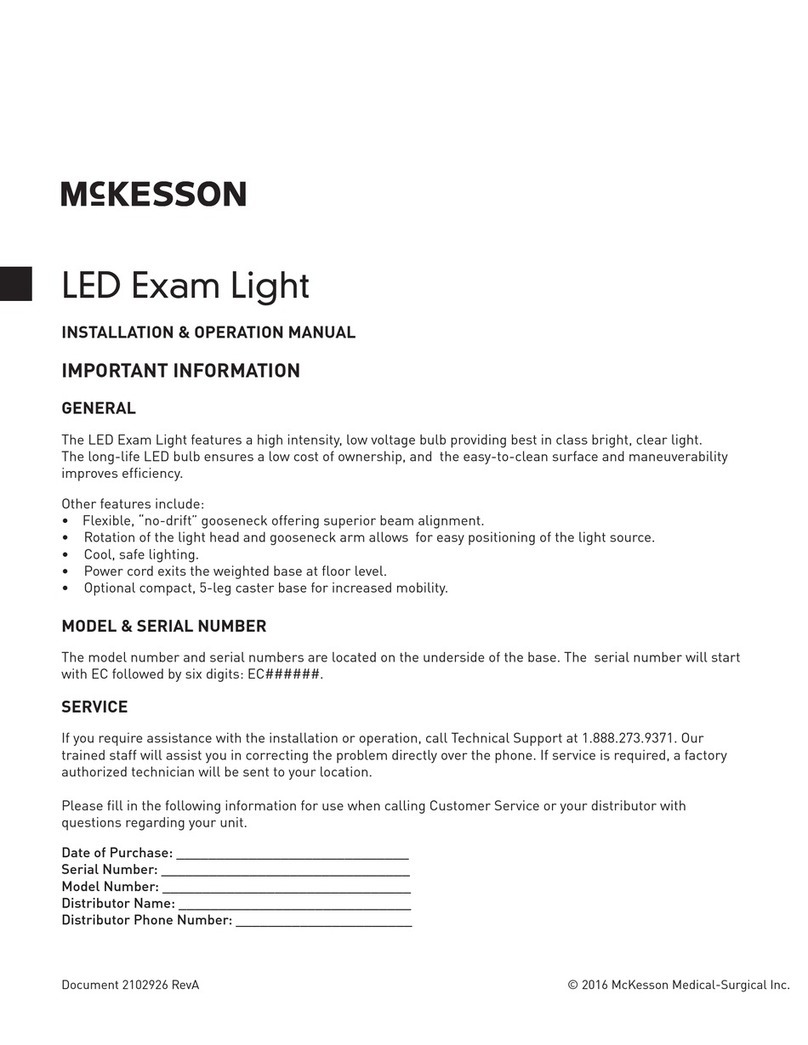Circadiance SmartMonitor 2 PS Manual

®
Checkout Procedure for SmartMonitor 2 PS/PSL

© 2017, Circadiance, LLC

Page 3
TABLE OF CONTENTS
Introduction ................................................................................................................................................. 4
Required Equipment ................................................................................................................................... 4
Important Notes…Read Carefully.............................................................................................................. 4
Establishing Initial Alarm Set Points ........................................................................................................ 5
The Functional Self-Test ............................................................................................................................ 7
Checkout Set-up.......................................................................................................................................... 8
Verification of Respiration Signal Sensitivity for SmartMonitor 2 PS ..................................................10
Verification of the ECG Signal Sensitivity for SmartMonitor 2 PS....................................................... 12
Verification of the Apnea Alarm and Delay ............................................................................................ 14
Verification of the Low Breath Rate Alarm............................................................................................. 15
Verification of the Low and High Heart Alarms...................................................................................... 17
Verification of the SpO2 Alarms............................................................................................................... 18
Verification of Cardiogenic Artifact Rejection ....................................................................................... 19
Verification of Loose Connection Alarm ................................................................................................ 19
Verification of Accidental Power-off Alarm (Sibling Alarm) ................................................................. 20
Operational Verification of the Main Battery Pack ................................................................................ 20
Clock Chip Battery.................................................................................................................................... 21
Operational Verification of the Nurse Call Feature (optional) .............................................................. 21
Watchdog Test .......................................................................................................................................... 22
Transferring SmartMonitor 2 PS data to a Memory Card...................................................................... 23
Computer Retrieval of SmartMonitor 2 PS Data ....................................................................................23
Clear Memory ............................................................................................................................................ 23
Circadiance SmartMonitor 2 PS Apnea Monitor Verification Checklist .............................................. 24

Page 4
INTRODUCTION
The manual provides procedures to determine if the Circadiance SmartMonitor 2 PS/PSL and its
accessories are suitable for use in patient applications. These procedures require the use of a calibrated
Model 5000 Simulator or Fluke ProSim 2 Simulator which is the source of ECG and respiratory test
signals. A Masimo Pulse Oximetry Tester is used to verify proper operation of the internal oximeter. No
other simulators are acceptable for use while performing these procedures.
This manual is for performance testing and is not intended as a service or repair guide. The procedures
contained in this manual are to be performed between each patient use or every 6-12 months. Monitors
that have been used in a home environment should always be tested between patients.
Operational information for the monitor can be found in the Professional Operator’s Manual.
The monitor must perform within the specifications of the procedures in this manual before use on
patients.
REQUIRED EQUIPMENT
¾SmartMonitor 2PS or SmartMonitor 2PSL
¾Respironics 5000 Simulator or Fluke ProSim 2
¾Safety Lead Wires (9520-1 or 1000114)
¾ECG Patient Cable (p/n 103019, 1030193 or 1030194)
¾Oximeter Patient Cable (p/n H 5870)
¾Stopwatch (optional)
¾PCMCIA Memory Card (p/n 1017915)
¾Masimo Tester
¾Multimeter
¾SmartMonitor 2 PS Nurse Call WYE Cable (p/n 1024837) or equivalent
IMPORTANT NOTES…READ CAREFULLY
As the checkout procedure is being performed, please remember the following:
¾Complete all checkout procedures in one continuous operation and in the order presented in this
manual. If you have not performed the checkout procedure before, please read and understand this
manual before starting the checkout procedure.
¾Do not place the monitor or the Simulator near electrical appliances that could cause interference
(i.e., cordless or cellular telephones, air conditioners, vaporizers, computers, TVs, VCRs, microwave
ovens, etc.)
¾Coiling and/or manipulation of the patient cables or lead wires should be minimized.
¾Once changes are made on the simulator, do not maintain hand contact with the simulator knobs or
enclosure. It may affect the ECG and respiration signals.
¾Because the signal from the simulator is interrupted by each change in the simulator setting, allow
approximately ten seconds after each setting change for the monitor circuitry to stabilize.
¾In the section of Establishing Initial Alarm Set Points of the checkout procedure, the changes to the
alarm parameters of the monitor should be made through the menu display located on the bottom
panel of the monitor.
¾The 5000 Simulator will not function correctly if the 9-volt battery is low. It should be replaced,
minimally, once per month or more often with heavy use. The battery voltage can be too low for
calibrated output signals before activation of the LOW BATTERY light.
¾The monitor's memory should be cleared before performing the checkout procedures.

Page 5
ESTABLISHING INITIAL ALARM SET POINTS
1. Remove the Menu Display Cover from the bottom of the SmartMonitor 2 PS or PSL. Note the three
buttons to the right of the LCD display: the UP arrow button, the DOWN arrow button, and the
ENTER button.
2. Access the Menu Mode for the monitor as follows:
a. Press the POWER button ON.
b. Within ten seconds, enter the following key code:
c. Press the DOWN arrow once.
d. Press the UP arrow twice.
e. Press the ENTER button three times.
NOTE
While in Menu Mode, the monitor will beep every 10 seconds. This is to remind you that the monitor is
not monitoring and to power off the monitor after parameters are set.
3. To set a specific parameter or series of parameters:
a. Use the UP arrow button to move forward to the parameter to be changed.
b. Select the parameter to be changed by pressing the ENTER key – this will cause the current
value to flash.
c. The value can be increased by pressing the UP arrow button and decreased by pressing the
DOWN arrow button.
d. To select the displayed value, press the ENTER button. The value displayed will continueto
flash until you press the ENTER button.
e. Press the UP arrow button to proceed to the next parameter to be selected.
4. For this checkout procedure, set the monitor parameters as follows:
Table 1
Parameter Value Parameter Value
Menu Options All Menus Probe Off Function Do Events, Do
Alarms
View Prior Events? No Low SpO2Alarm*75%
Patient Name Test ^ High SpO2Alarm*OFF
Patient ID Number 00 ^ Low SpO2Alarm Delay*5 Seconds
STD Alarm Parameters Are Not Selected SpO2Record Limit*OFF
STD Record Parms. Are Selected Record SpO2?*YES
STD System Parms. Are Not Selected Rec. Plethysmograph?*YES
Apnea Alarm 20 Seconds Record Pulse Rate?*NO
Low Breath Alarm 0FF Record Auxiliary 1 OFF
Bradycardia Alarm 80 BPM Record Auxiliary 2 OFF
Brady Alarm Delay 0 seconds Record Auxiliary 3 OFF
Tachycardia Alarm 230 BPM Record Auxiliary 4 OFF
Tachy Alarm Delay 5 Seconds Ext. Physio Trigger OFF
Record Mode EVENT Ext. Equip. Trigger OFF
Apnea Record Limit 16 Seconds Date Current Date
Brady Record Limit OFF Time Current Time
Pre/Post Time 30/15 Rate Display ON
Record Impedance? YES Computer Phone # (___-____)
Record Resp Rate? YES When to Call (__/__/__ __:__)
Record Heartrate? YES Dial if Memory Full? Yes
Record ECG? YES Move Data to Card? NO
Oximeter Enabled YES Memory Status 0 Percent Full
Enable Panel Display YES Clear Memory? YES
*Available on SmartMonitor 2PS monitors only.

Page 6
5. After the designated checkout parameters are entered, turn the monitor off using the
proper Power-off procedure*. The proper power-off procedure is as follows:
a. Press and hold the RESET button.
b. Press and release the POWER button.
c. Wait two seconds, and then release the RESET button.
6. For monitors used in locations where the mains power is 50 Hz, perform the
following steps to ensure that the AC POWER INPUT setting is set to 50 Hz
a. Turn the monitor on.
b. When the LCD screen on the bottom of the monitor displays “MENU MODE?
ENTER PROPER KEY SEQUENCE”, press the UP arrow button, DOWN arrow
button, ENTER button, UP arrow button, DOWN arrow button, ENTER button.
The monitor will now display SmartMonitor 2PS menu selection.
c. Use the UP or DOWN arrows to scroll to the menu option labeled “AC POWER
INPUT”. Verify that the menu displays 50 Hz. If the menu displays 50 Hz.,
power off the unit.
d. If the menu displays 60 Hz., Press the ENTER button to make the 60 Hz. blink.
e. Use either the UP or DOWN arrow button to select 50 Hz.
f. Press the ENTER button.
g. Power the monitor off.
NOTE
*If the Hospital Mode parameter is set to YES, the special power-off procedure described above is not
required. Refer to the Professional Operator’s Manual for further details on setting the Hospital Mode
parameter. Within this procedure, all functionality and stopwatch timing is based on the Hospital Mode
Parameter being set to NO.

Page 7
THE FUNCTIONAL SELF-TEST
1. Plug the power supply into a live wall outlet and connect the other end into the DC POWER
receptacle on the back of the monitor. The CHARGER light on the front of the SmartMonitor
2 PS should light and remain on (continuous or blinking).
2. Insert the ECG patient cable into the ECG receptacle on the front of the monitor.
3. Insert the WHITE lead (RA) wire into the “RA” socket of the patient cable. Insert the BLACK lead wire
into the “LA” socket of the patient cable. Make sure that both lead wires are fully inserted into the
color-coded sockets of the patient cable.
4. Connect the lead wires to the Functional Self-Test receptacles on the right side of the SmartMonitor 2
PS. Insert the pin end of the WHITE lead wire into the receptacle labeled “RA”. Insert the pin end of
the BLACK lead wire into the receptacle labeled “LA”.
5. If testing a SmartMonitor 2PS monitor,insert the Oximeter patient cable into the Oximeter receptacle
on the front of the SmartMonitor 2 PS.
6. If testing a SmartMonitor 2PS, connect the Masimo Tester to the other end of the Oximeter patient
cable.
NOTE
When using a stopwatch, timing should begin after the power button has been pressed.
NOTE
The LED on the Masimo Tester will blink when the SmartMonitor 2 PS is turned on. After a few
moments, the tester LED will stop blinking and stay lit, during this time the display of the
SmartMonitor 2 PS may display three dashed lines on the display and the alarm will sound. This is a
normal condition. A few moments after the tester LED stays lit, the alarm will stop sounding and the
SpO2display of the SmartMonitor 2 PS should display a reading of 81 ± 3%. This will occur each
time the SmartMonitor 2 PS is turned on when this tester is being used throughout this procedure.
7. Press the POWER button to turn the monitor on. The alarm should beep and all the lights
should come on for approximately 4 seconds. After all the alarm lights turn off, the CHARGER and
POWER light should remain on and within 15 seconds, the green HEART and RESPIRATION light
should be blinking. The lights will continue to flash for about 45 seconds.
NOTE
If the following lights remain on or are blinking, and/or the alarm sounds continuously,
corrective action should be taken before continuing the Checkout Procedure.
¾LOW BATTERY – The monitor battery pack is discharged. Turn the SmartMonitor 2 PS off
using the correct power-off procedure. Make sure the Power supply is plugged into a live power
outlet and properly connected to the monitor. Allow the monitor to recharge for 8 hours before
performing the Checkout Procedure. This will provide fully charged battery power.
¾FULL MEMORY – The monitor's memory is 80% to 100% full. If the monitor has been used
on patients, the data should be transferred and then cleared using the procedure described
in the Professional Operator’s Manual.
¾LOOSE CONNECTION – Indicates loose or bad lead wires or patient cable. Check all
connections and/or replace lead wires first, then patient cable if necessary.
NOTE
The Masimo Tester simulates a nominal % SpO2value of 81 ± 3%. Throughout this
section of the checkout procedure, the displayed % SpO2value should remain within
this range and SpO2alarms should not be generated.
8. After approximately 45 seconds, the green HEART and RESPIRATION lights should stop blinking.
The red LOW HEART light should illuminate within approximately seven seconds after the HEART
light stops flashing, and the audible alarm should beep once every second.

Page 8
9. Approximately 20 seconds after the last Respiration detection, the Red Apnea light should illuminate.
(There should be no green HEART or RESPIRATION lights during this alarm.) When the APNEA
light illuminates, the Functional Self-test is complete.
10. Turn the SmartMonitor 2 PS off using the correct power-off procedure. If the SmartMonitor 2 PS is
not powered off correctly, the “sibling” alarm will sound. Repeat the proper Power-off procedure as
described above until power is off.
CHECKOUT SET-UP
NOTE
The power supply and the Patient Cables should remain connected
to the monitor as they were in the Functional Self-Test.
1. Disconnect the lead wires from the Self-Test connectors of the monitor.
2. If using a model 5000 simulator loosen the binding post caps (labeled “RA” and “LA”) on the
Model 5000 Simulator under THREE LEAD ECG/RESP.
3. Insert the white lead wire into the post-labeled “RA”. Insert the black lead wire into the post-
labeled “LA”. Tighten both post caps on the 5000 Simulator. If using a Fluke ProSim 2
simulator, insert the lead wires into the appropriate connectors on the Fluke simulator".
4. Set the Simulator Controls as follows:
Table 2
Parameter Value Parameter Value
Patient Name Test Record Heart Rate YES
Patient ID Number 1234 Record ECG YES
STD Alarm Parameters Are Selected Record Auxiliary 1 OFF
STD Record Parms Not Selected Record Auxiliary 2 OFF
STD System Parms Not Selected Record Auxiliary 3 OFF
Apnea Alarm 20 Seconds Record Auxiliary 4 OFF
Low Breath Rate Alarm 0FF External Physiological Trigger OFF
Bradycardia Alarm 80 BPM External Equipment Trigger OFF
Bradycardia Alarm Delay 0 seconds Date Current Date
Tachycardia Alarm 230 BPM Time Current Time
Tachy Alarm Delay 5 Seconds Rate Display ON
Record Mode EVENT Phone Number For Computer (___-____)
Apnea for Record 16 Seconds Time to Call the Computer (__/__/__ __:__)
Brady Limit Record OFF Dial if Memory Is Full NO
Pre/Post Time 30/15 Move Data to Card NO
Record Impedance? YES Memory Status 0 Percent Full
Record Respiration Rate YES Clear Memory NO

Page 9
NOTE
The LED on the Masimo Tester will blink when the SmartMonitor 2 PS is turned on.
After a few moments, the tester LED will stop blinking and stay lit, during this time the
display of the SmartMonitor 2 PS may display three dashed lines onthe display and the
alarm will sound. This is a normal condition. A few moments after the tester LED stays
lit, the alarm will stop sounding and the SpO2display of the SmartMonitor 2 PS should
display a reading of 81 ± 3%. This will occur each time the SmartMonitor 2 PS is
turned on when this tester is beingusedthroughout this procedure.
5. Turn the Simulator POWER on.
6. Turn the SmartMonitor 2 PS power on and proceed to Verification of Respiration Signal
Sensitivity.
NOTE
If the Monitor Alarms at this point, check the Menu Display, if an Error Code is
displayed, check to ensure the AAA backup batteries are installed and within voltage
tolerances. If the AAA batteries are correctly installed and functional, then check the
5000 simulator battery or that the Fluke simulator is operating properly

Page 10
VERIFICATION OF RESPIRATION SIGNAL SENSITIVITY FOR Monitor
There are 17 test points that require different simulator settings. For each test point, make the
required changes as listed in Table 3 and verify the appropriate monitor response. Simulator
Control setting values that change from the previous Test Point are marked with an asterisk
(*). Press the RESET button on the SmartMonitor 2 to reset any alarm faults.
NOTE
Apnea should occur approximately 20 seconds after the last respiration detection.
NOTE
The Masimo Tester simulates a nominal % SpO2value of 81 ± 3%. Throughout
this section of the checkout procedure, the displayed % SpO2value should remain
within this range and SpO2alarms should not be generated.
NOTE
Because the signal from the simulator is interrupted by each change in the
simulator setting, allow approximately ten seconds after each setting change for
the monitor circuitry to stabilize.
Table 3
Test
Point
Simulator Control Model
5000
Setting
Fluke
ProSim™ 2
Setting
Smart Monitor 2 Response
1
ECG BEATS/MIN. 200 200
No Alarms
100% Detection
ECG AMPLITUDE/MV. 0.5 0.5
Resp. Breath / MIN 10 15
Variation OHMS 0.5 0.5
Base Impedance Ohms 200 500
2
ECG BEATS/MIN. 200 200
No respiration detection
Apnea light should illuminate and audible alarm
should beep once per second 20 seconds (+/- 1)
ECG AMPLITUDE/MV. 0.5 0.5
Resp. Breath / MIN 10 15
Variation OHMS 0.1* Apnea 22
seconds*
Base Impedance Ohms 200 500
3
ECG BEATS/MIN. 200 200 No alarms
100% Detection
Press Reset button to clear alarm faults and red
light.
ECG AMPLITUDE/MV. 0.5 0.5
Resp. Breath / MIN 15* 15*
Variation OHMS 0.5* 0.5*
Base Impedance Ohms 200 500
4
ECG BEATS/MIN. 200 200
No respiration detection
Apnea light should illuminate and audible alarm
should beep once per second 20 seconds (+/- 1)
ECG AMPLITUDE/MV. 0.5 0.5
Resp. Breath / MIN 15 15
Variation OHMS 0.1* Apnea 22
seconds*
Base Impedance Ohms 200 500
5
ECG BEATS/MIN. 200 200 No alarms
100% Detection
Press Reset button to clear alarm faults and red
light.
ECG AMPLITUDE/MV. 0.5 0.5
Resp. Breath / MIN 30* 30*
Variation OHMS 0.2* 0.2*
Base Impedance Ohms 200 500

Page 11
6
ECG BEATS/MIN. 200 200 No respiration detection
Apnea light should illuminate and audible alarm
should beep once per second 20 seconds (+/- 1)
after last respiration is detected.
ECG AMPLITUDE/MV. 0.5 0.5
Resp. Breath / MIN 30 30
Variation OHMS 0.1* Apnea 22
seconds*
Base Impedance Ohms 200 500
7
ECG BEATS/MIN. 200 200 No alarms
100% Detection
Press Reset button to clear alarm faults and red
light.
ECG AMPLITUDE/MV. 0.5 0.5
Resp. Breath / MIN 50* 60*
Variation OHMS 0.2* 0.2*
Base Impedance Ohms 200 500
8
ECG BEATS/MIN. 200 200
No respiration detection
Apnea light should illuminate and audible alarm
should beep once per second 20 seconds (+/- 1)
ECG AMPLITUDE/MV. 0.5 0.5
Resp. Breath / MIN 50 40
Variation OHMS 0.1* Apnea 22
seconds*
Base Impedance Ohms 200 500
9
ECG BEATS/MIN. 200 200 No alarms
100% Detection
Press Reset button to clear alarm faults and red
light.
ECG AMPLITUDE/MV. 0.5 0.5
Resp. Breath / MIN 75* 80*
Variation OHMS 0.5* 0.5*
Base Impedance Ohms 200 500
10
ECG BEATS/MIN. 200 200 No respiration detection
Apnea light should illuminate and audible alarm
should beep once per second 20 seconds (+/- 1)
ECG AMPLITUDE/MV. 0.5 0.5
Resp. Breath / MIN 75 80
Variation OHMS 0.1* Apnea 22
seconds*
Base Impedance Ohms 200 500
11
ECG BEATS/MIN. 200 200 No alarms
100% Detection
Press Reset button to clear alarm faults and red
light.
ECG AMPLITUDE/MV. 0.5 0.5
Resp. Breath / MIN 100* 100*
Variation OHMS 0.5* 0.5*
Base Impedance Ohms 200 500
12
ECG BEATS/MIN. 200 200
No respiration detection
Apnea light should illuminate and audible alarm
should beep once per second 20 seconds (+/- 1)
ECG AMPLITUDE/MV. 0.5 0.5
Resp. Breath / MIN 100 100
Variation OHMS 0.1* Apnea 22
seconds*
Base Impedance Ohms 200 500
13
ECG BEATS/MIN. 200 200 No alarms
100% Detection
Press Reset button to clear alarm faults and red
light.
ECG AMPLITUDE/MV. 0.5 0.5
Resp. Breath / MIN 120* 120*
Variation OHMS 1* 1*
Base Impedance Ohms 200 500
14
ECG BEATS/MIN. 200 200
No respiration detection
Apnea light should illuminate and audible alarm
should beep once per second 20 seconds (+/- 1)
ECG AMPLITUDE/MV. 0.5 0.5
Resp. Breath / MIN 120 120
Variation OHMS 0.1* Apnea 22
seconds*
Base Impedance Ohms 200 500

Page 12
VERIFICATION OF THE ECG SIGNAL SENSITIVITY FOR Monitor
There are 13 test points that require different simulator settings. For each test point, make the
required changes as listed in Table 4 and verify the appropriate monitor response. Simulator
Control setting values that change from the previous Test Point are marked with an asterisk
(*). Press the RESET button on the SmartMonitor 2 PS to reset any alarm faults.
NOTE
Apnea should occur approximately 20 seconds after the last respiration detection.
NOTE
The Masimo Tester simulates a nominal % SpO2value of 81 ± 3%. Throughout
this section of the checkout procedure, the displayed % SpO2value should remain
within this range and SpO2alarms should not be generated.
NOTE
Because the signal from the simulator is interrupted by each change in the
simulator setting, allow approximately ten seconds after each setting change for
the monitor circuitry to stabilize.
Table 4
Test
Point
Simulator Control Model
5000
Setting
Fluke
ProSim™
2 Setting
Smart Monitor 2 Response
1
ECG BEATS/MIN. 25 30 100% Detections
Low heart light should illuminate and audible alarm
should beep once per second.
ECG AMPLITUDE/MV. 0.2 0.3
Resp. Breath / MIN 15 15
Variation OHMS 1 1
Base Impedance Ohms 200 500
2
ECG BEATS/MIN. 85* 90* 100% Detections
Audible alarm should stop. Press Reset to reset Low
Heart light.
ECG AMPLITUDE/MV. 0.2 0.3
Resp. Breath / MIN 15 15
Variation OHMS 1 1
Base Impedance Ohms 200 500
3
ECG BEATS/MIN. 85 90 No ECG Detections
Low heart light should illuminate and audible alarm
should beep once per second.
ECG AMPLITUDE/MV. 0.1* 0.1*
Resp. Breath / MIN 15 15
Variation OHMS 1 1
Base Impedance Ohms 200 500

Page 13
4
ECG BEATS/MIN. 100* 100* 100% Detections
Audible alarm should stop. Press Reset to reset Low
Heart light.
ECG AMPLITUDE/MV. 0.2* 0.3*
Resp. Breath / MIN 15 15
Variation OHMS 1 1
Base Impedance Ohms 200 500
5
ECG BEATS/MIN. 100 100 No ECG Detections
Low Heart light should illuminate and audible alarm
should beep once per second.
ECG AMPLITUDE/MV. 0.1* 0.1*
Resp. Breath / MIN 15 15
Variation OHMS 1 1
Base Impedance Ohms 200 500
6
ECG BEATS/MIN. 150* 140* 100% Detections
Audible alarm should stop. Press Reset to reset Low
Heart light.
ECG AMPLITUDE/MV. 0.2* 0.3*
Resp. Breath / MIN 15 15
Variation OHMS 1 1
Base Impedance Ohms 200 500
7
ECG BEATS/MIN. 150 140 No ECG Detections
Low Heart light should illuminate and audible alarm
should beep once per second.
ECG AMPLITUDE/MV. 0.1* 0.1*
Resp. Breath / MIN 15 15
Variation OHMS 1 1
Base Impedance Ohms 200 500
8
ECG BEATS/MIN. 200* 200* 100% Detections
Audible alarm should stop. Press Reset to reset Low
Heart light.
ECG AMPLITUDE/MV. 0.5* 0.5*
Resp. Breath / MIN 15 15
Variation OHMS 1 1
Base Impedance Ohms 200 500
9
ECG BEATS/MIN. 200 200 No ECG Detections
Low Heart light should illuminate and audible alarm
should beep once per second.
ECG AMPLITUDE/MV. 0.1* 0.1*
Resp. Breath / MIN 15 15
Variation OHMS 1 1
Base Impedance Ohms 200 500
10
ECG BEATS/MIN. 240* 240* 100% Detections
Press Reset to reset Low Heart light. High Heart
light should illuminate and audible alarm should beep
Twice per second.
ECG AMPLITUDE/MV. 0.5* 0.5*
Resp. Breath / MIN 15 15
Variation OHMS 1 1
Base Impedance Ohms 200 500
11
ECG BEATS/MIN. 240 240 No ECG Detections
Low Heart light should illuminate and audible alarm
should beep once per second.
ECG AMPLITUDE/MV. 0.1* 0.1*
Resp. Breath / MIN 15 15
Variation OHMS 1 1
Base Impedance Ohms 200 500
12
ECG BEATS/MIN. 200* 200*
100% Detection
Press Reset button to reset High and Low Heart.
ECG AMPLITUDE/MV. 0.5* 0.5*
Resp. Breath / MIN 15 15
Variation OHMS 1 1
Base Impedance Ohms 200 500

Page 14
VERIFICATION OF THE APNEA ALARM AND DELAY
There are 3 test points that require different simulatorsettings. For each test point, make the
required changes as listed in Table 5 and verify the appropriate monitor response. Simulator
Control setting values that change from the previous Test Point are marked with an asterisk
(*). Press the RESET button on the monitor to reset any alarm faults.
NOTE
The Masimo Tester simulates a nominal % SpO2 value of 81 ± 3%. Throughout
this section of the checkout procedure, the displayed % SpO2value should remain
within this range and SpO2alarms should not be generated.
NOTE
Because the signal from the simulator is interrupted by each change in the
simulator setting, allow approximately ten seconds after each setting change for
the monitor circuitry to stabilize.
Table 5
Test
Point
Simulator Control Model 5000
Setting
Fluke
ProSim™ 2
Setting
Smart Monitor 2 Response
1
ECG BEATS/MIN. 200 200
No Alarms
100% Detections
ECG AMPLITUDE/MV. 0.5 0.5
Resp. Breath / MIN 15 15
Variation OHMS 1 1
Base Impedance Ohms 200 500
2
ECG BEATS/MIN. 200 200 No respiration detection
Apnea light should illuminate and audible alarm
should beep once per second
20 seconds (+/- 1)
ECG AMPLITUDE/MV. 0.5 0.5
Resp. Breath / MIN 15 15
Variation OHMS 0.1* Apnea 22
seconds*
Base Impedance Ohms 200 500
3
ECG BEATS/MIN. 200 200 100% Detection
Press Reset button to clear alarm faults and red
light.
ECG AMPLITUDE/MV. 0.5 0.5
Resp. Breath / MIN 15 15
Variation OHMS 0.5* 0.5*
Base Impedance Ohms 200 500

Page 15
VERIFICATION OF THE LOW BREATH RATE ALARM
NOTE
The Masimo Tester simulates a nominal % SpO2value of 81 ± 3%. Throughout this
section of the checkout procedure, the displayed % SpO2value should remain within
this range and SpO2alarms should not be generated.
NOTE
The LED on the Masimo Tester will blink when the SmartMonitor 2 PS is turned on.
After a few moments, the tester LED will stop blinking and stay lit, during this time the
display of the SmartMonitor 2 PS may display three dashed lines on the display and the
alarm will sound. This is a normal condition. A few moments after the tester LED stays
lit, the alarm will stop sounding and the SpO2display of the SmartMonitor 2 PS should
display a reading of 81 ± 3%. This will occur each time the SmartMonitor 2 PS is turned
on when this tester is being used throughout this procedure.
NOTE
Because the signal from the simulator is interrupted by each change in the simulator
setting, allow approximately ten seconds after each setting change for the monitor
circuitry to stabilize.
1. Turn the monitor off as follows:
a. Press and hold the RESET button.
b. Press and release the POWER button.
c. Wait two seconds, and then release the RESET button.
2. Access the Menu Mode for the monitor as follows:
a. Press the POWER button ON.
b. Within ten seconds, enter the following key code:
c. Press the DOWN arrow once.
d. Press the UP arrow twice.
e. Press the ENTER button three times.
3. Change the entry for LOW BREATH ALARM from OFF to 16 BrPM for the Model 5000
or 18 BrPM for the Fluke ProSim™ 2 Simulator.
4. In order for the monitor to accept the parameter value changes, turn the SmartMonitor 2
PS off as described in step 1 above.
5. Set the Simulator Controls as shown in Test Point 1 in Table 6.
6. Power on themonitor.
7. Test the SmartMonitor per Table 6.

Page 16
Table 6
8. Turn the monitor off as described in step 1 above.
9. Access the Menu Mode for the monitor as described in step 2 above.
10. Change the setting for LOW BREATH ALARM.
11. Turn the monitor off as described in step 1 above.
12. Power on the monitor. (The monitor must be powered off and then on for the changed parameter
values to be accepted.)
Test
Point
Simulator Control Model 5000
Setting
Fluke
ProSim™
2 Setting
Smart Monitor 2 Response
1
ECG BEATS/MIN. 100* 100*
No Alarms
100% Detections
ECG
AMPLITUDE/MV. 0.5 0.5
Resp. Breath / MIN 30* 30*
Variation OHMS 1* 1*
Base Impedance
Ohms 200 500
2
ECG BEATS/MIN. 100 100
No respiration detection
Apnea light should illuminate and audible alarm
should beep once per second
20 seconds (+/- 1)
ECG
AMPLITUDE/MV. 0.5 0.5
Resp. Breath / MIN 10* 15*
Variation OHMS 1 1
Base Impedance
Ohms 200 500
3
ECG BEATS/MIN. 100 100
The audible alarm should stop within approximately 7
seconds, but the Apnea light should remain flashing.
Press Reset button to clear alarm and faults.
ECG
AMPLITUDE/MV. 0.5 0.5
Resp. Breath / MIN 30* 30*
Variation OHMS 1 1
Base Impedance
Ohms 200 500

Page 17
VERIFICATION OF THE LOW AND HIGH HEART ALARMS
NOTE
Due to large signal changes that result when Simulator settings are initially changed,
the off-scale signal recognition circuitry of the monitor may activate and cause brief
pauses in detection once the normal signal is detected by the monitor. This would
allow an additional 10 seconds for the circuitry to stabilize before proceeding with
verifying the operation of the SmartMonitor 2 PS.
NOTE
The Masimo Tester simulates a nominal % SpO2value of 81 ± 3%. Throughout this
section of the checkout procedure, the displayed % SpO2value should remain within
this range and SpO2alarms should not be generated.
NOTE
Because the signal from the simulator is interrupted by each change in the simulator
setting, allow approximately ten seconds after each setting change for the monitor
circuitry to stabilize.
Table 7
Test
Point
Simulator Control Model
5000
Setting
Fluke
ProSim™ 2
Setting
Smart Monitor 2 Response
1
ECG BEATS/MIN. 85* 90*
No Alarms
100% Detections
ECG AMPLITUDE/MV. 0.5 0.5
Resp. Breath / MIN 30 30
Variation OHMS 1 1
Base Impedance Ohms 200 500
2
ECG BEATS/MIN. 75* 60* Red Low Heart light should illuminate and
audible alarm should sound once per second.
Green Respiration should flash.
ECG AMPLITUDE/MV. 0.5 0.5
Resp. Breath / MIN 30 30
Variation OHMS 1 1
Base Impedance Ohms 200 500
3
ECG BEATS/MIN. 85* 90* The audible alarm will stop and the red Low
Heart light will remain on.
Press Reset button to Low Heart light
ECG AMPLITUDE/MV. 0.5 0.5
Resp. Breath / MIN 30 30
Variation OHMS 1 1
Base Impedance Ohms 200 500
4
ECG BEATS/MIN. 240* 240* Red High Heart light should illuminate and the
audible alarm should beep twice per second.
ECG AMPLITUDE/MV. 0.5 0.5
Resp. Breath / MIN 30 30
Variation OHMS 1 1
Base Impedance Ohms 200 500
5
ECG BEATS/MIN. 200* 200* The audible alarm will stop and the red High
Heart light will remain on.
Press Reset button to High Heart light.
ECG AMPLITUDE/MV. 0.5 0.5
Resp. Breath / MIN 30 30
Variation OHMS 1 1
Base Impedance Ohms 200 500

Page 18
VERIFICATION OF THE SPO2 ALARMS (Only performed on SmartMonitor 2PS monitors)
1. Disconnect the Masimo Tester from the Oximeter patient cable.
2. After a short delay, the SpO2light will turn red, the SpO2display will show dashes, and the audible
alarm will sound.
3. Reconnect the Masimo Tester to the Oximeter patient cable.
4. Verify that the SpO2light turns green, the SpO2display shows a value of 81 ± 3%, and the audible
alarm stops sounding.
5. Turn the SmartMonitor 2 PS off using the proper Power-off procedure.
6. Turn the SmartMonitor 2 PS on, enter Menu Mode, and change the Low SpO2Alarm parameter to
85%.
7. Turn the SmartMonitor 2 PS on.
8. Verify that the SpO2display shows a value of 81 ± 3%. In addition, verify that the Low SpO2light
comes on and the audible alarm beeps once per second.
9. Turn the SmartMonitor 2 PS off using the proper Power-off procedure.
10. Turn the SmartMonitor 2 PS on, enter Menu Mode, and change the Low SpO2Alarm parameter to
75%.

Page 19
VERIFICATION OF CARDIOGENIC ARTIFACT REJECTION
NOTE
The Masimo Tester simulates a nominal % SpO2value of 81 ± 3%. Throughout this
section of the checkout procedure, the displayed % SpO2value should remain within
this range and SpO2alarms should not be generated.
NOTE
Because the signal from the simulator is interrupted by each change in the simulator
setting, allow approximately ten seconds after each setting change for the monitor
circuitry to stabilize.
VERIFICATION OF LOOSE CONNECTION ALARM
NOTE
The Masimo Tester simulates a nominal % SpO2value of 81 ± 3%. Throughout this
section of the checkout procedure, the displayed % SpO2value should remain within
this range and SpO2alarms should not be generated.
NOTE
Because the signal from the simulator is interrupted by each change in the simulator
setting, allow approximately ten seconds after each setting change for the monitor
circuitry to stabilize.
1. Disconnect the Patient Cable from the monitor. The audible alarm should sound continuously and
the LOOSE CONNECTION LIGHT should illuminate.
2. Reconnect the Patient Cable. The audible alarm should stop. Press the RESET button to reset the
LOOSE CONNECTION LIGHT. The GREEN HEART LIGHT and GREEN RESPIRATION LIGHT
should resume flashing.
Test
Point
Simulator Control Model 5000
Setting
Fluke
ProSim™ 2
Setting
Smart Monitor 2 Response
1
ECG BEATS/MIN. 100* 100*
No Alarms
100% Detections
ECG AMPLITUDE/MV. 0.5 0.5
Resp. Breath / MIN 30 30
Variation OHMS 1 1
Base Impedance Ohms 200 500
2
ECG BEATS/MIN. 100 100 No respiration detection
Apnea light should illuminate and audible
alarm should beep once per second 20
seconds (+/- 1) after last respiration is
detected.
ECG AMPLITUDE/MV. 0.5 0.5
Resp. Breath / MIN 100* 100*
Variation OHMS 1 1
Base Impedance Ohms 200 500
3
ECG BEATS/MIN. 100 100 100% Detection
Press Reset button to clear alarm faults and
red light.
ECG AMPLITUDE/MV. 0.5 0.5
Resp. Breath / MIN 75* 80*
Variation OHMS 1 1
Base Impedance Ohms 200 500
Table 8

Page 20
3. Disconnect the White Lead Wire from the Simulator. The audible alarm should sound continuously
and the LOOSE CONNECTION LIGHT should come on. Reconnect the White Lead Wire. The
audible alarm should stop.
4. Press the RESET button to turn off the LOOSE CONNECTION LIGHT.
5. Disconnect the Black Lead Wire from the Simulator. The audible alarm should sound continuously
and the LOOSE CONNECTION LIGHT should illuminate.
6. Reconnect the Black Lead Wire. The audible alarm should stop.
7. Press the RESET button to turn off the LOOSE CONNECTION LIGHT.
8. After reconnecting the lead wires, set the Base Impedance Ohms to 1.5K on the Simulator. There
should be NO alarms.
Note: Perform steps 9-11 only with the Model 5000 simulator.
9. 9.Change the Base Impedance Ohms to 2K. The audible alarm should sound continuously and the
LOOSE CONNECTION LIGHT should illuminate.
10. 10.Change the Base Impedance Ohms back to 1.5K. The audible alarm should stop.
11. Press the RESET button to reset the LOOSE CONNECTION LIGHT.
1. Press the POWER button to turn the monitor off (without pressing the RESET button). The audible
alarm should sound continuously. The POWER LIGHT will illuminate.
2. Press the POWER button again, then press and hold down the RESET button. Press and release the
POWER button, and continue to press the RESET button for 2 seconds. The audible alarm should
stop and the POWER LIGHT should also go out. Release the RESET button.
OPERATIONAL VERIFICATION OF THE MAIN BATTERY PACK
The monitor uses two types of batteries. Rechargeable batteries are used for power during portable
operation. Alkaline batteries provide a back-up alarm function if the rechargeable batteries fail. The
rechargeable batteries are contained inside the main battery pack. Two alkaline, size AAA, batteries
are placed into a AAA holder located on the side of the main battery pack.
1. Unplug the Power supply from the monitor.
2. Remove the battery cover to gain access to the main battery pack.
3. Replace the AAA alkaline batteries and safely dispose of the old batteries in accordance with your
area’s environmental laws.
4. Replace the battery cover.
5. Repeat the Functional Self-test to verify battery operation. Refer to page 7.
NOTE
If the main battery pack is not sufficiently charged, the alarm will sound continuously,
and the LOW BATTERY LIGHT will turn on.
NOTE
The main battery pack has a life expectancy of 2-3 years and should be replaced on a
preventative basis within this time frame.
NOTE
The alkaline batteries should be replaced at least once each year to ensure their
function, if needed, for backup in the case of a main battery pack failure.
VERIFICATION OF ACCIDENTAL POWER-OFF ALARM (SIBLING
ALARM)
Other manuals for SmartMonitor 2 PS
1
This manual suits for next models
1
Table of contents
Other Circadiance Medical Equipment manuals
Popular Medical Equipment manuals by other brands
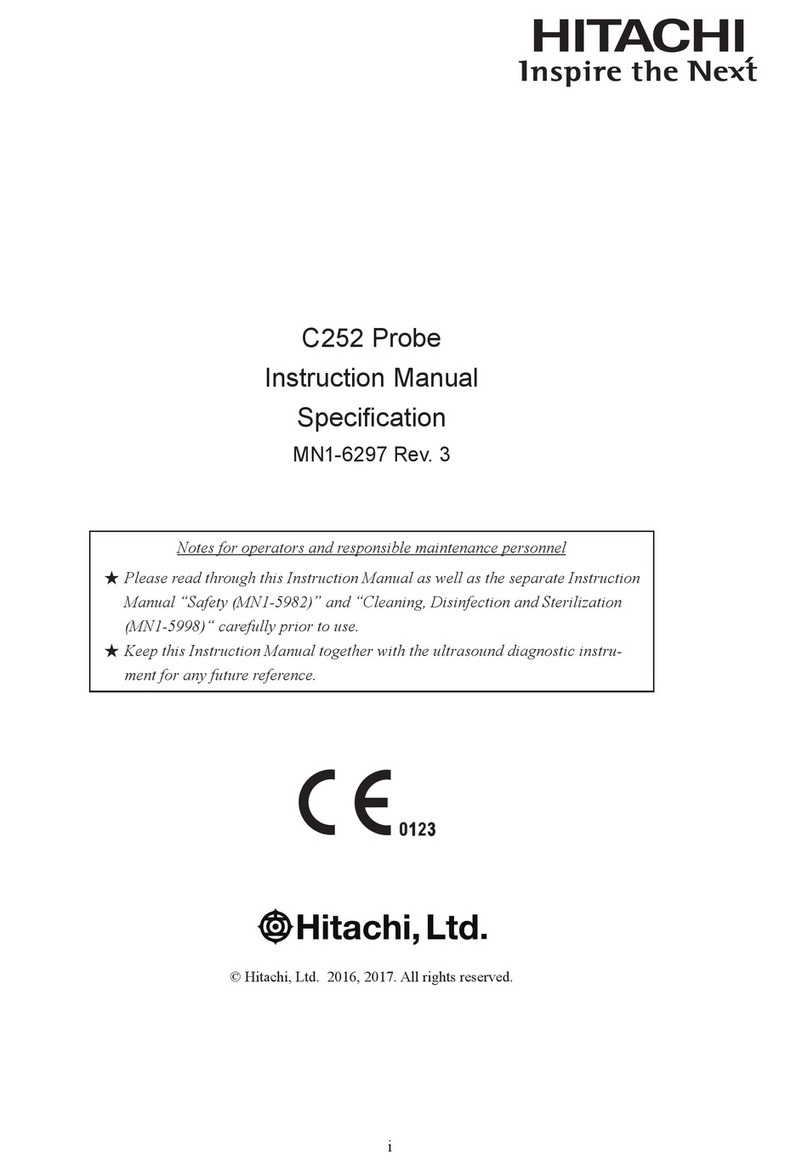
Hitachi
Hitachi C252 instruction manual
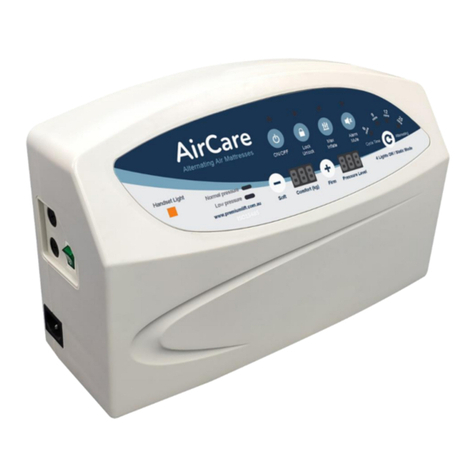
PremiumLift
PremiumLift AirCare Max-Pro ACMaxPP user manual
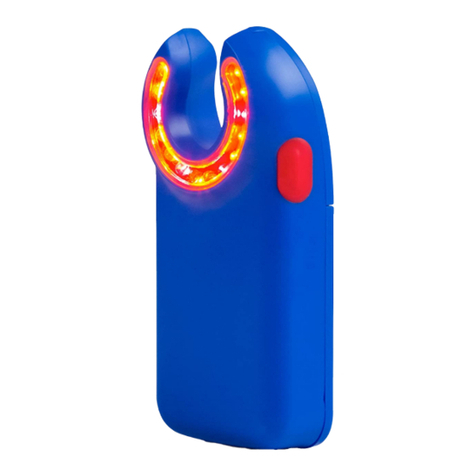
TransLite
TransLite Veinlite PEDI2 manual
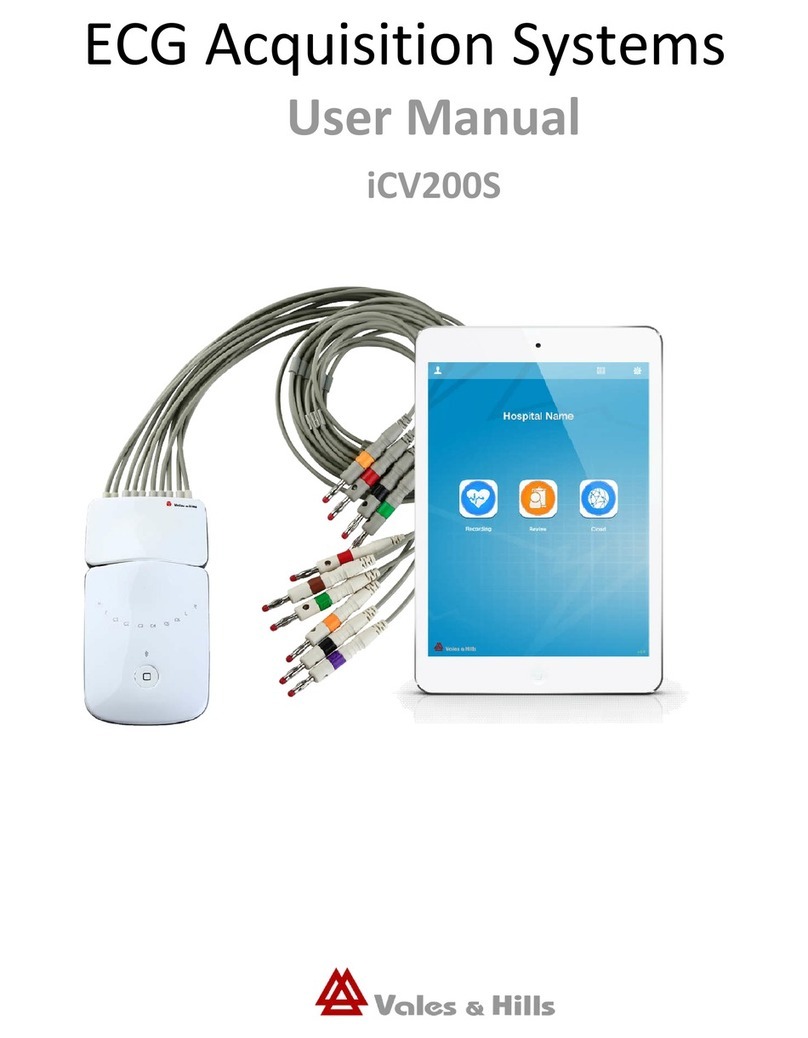
VALES & HILLS BIOMEDICAL TECH
VALES & HILLS BIOMEDICAL TECH iCV200S user manual

RJL systems
RJL systems QUANTUM V SEGMENTAL BIA user manual

Atmos
Atmos iQam operating instructions
